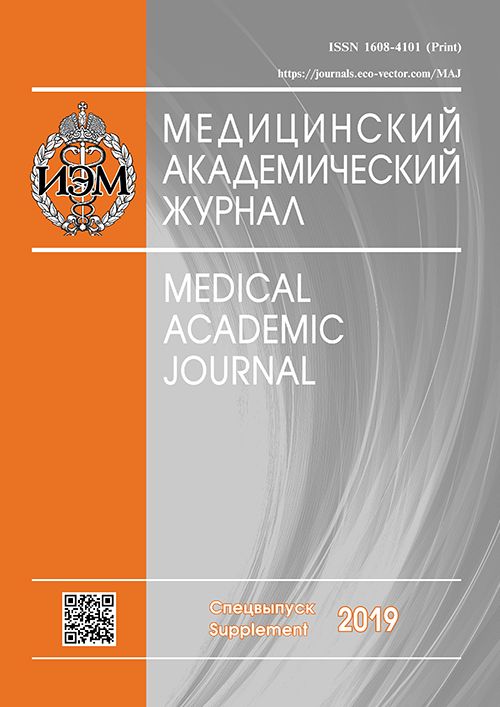The relevance of cytokine indicators in the hemorrhagic transformation development of cerebral infarction risk measuring
- Authors: Nikiforova TA1, Doronin BM2, Peskov SA1,2
-
Affiliations:
- VAT City Clinical Hospital No. 1, Novosibirsk
- Novosibirsk State Medical University, Novosibirsk
- Issue: Vol 19, No 1S (2019)
- Pages: 129-132
- Section: Articles
- Published: 15.12.2019
- URL: https://journals.eco-vector.com/MAJ/article/view/19362
- ID: 19362
Cite item
Abstract
The purpose of this research is to study the prognostic role of cytokines in plasma in patients with cerebral infarction while assessing the risk of hemorrhagic transformation.Materials and methods. Three groups of patients were identified. Group 1: 66 patients with cerebral infarction without hemorrhagic transformation (CI without HT), mean age 63.9 ± 1.3 years. Group 2: 27 patients with cerebral infarction and with hemorrhagic transformation (CI with HT), mean age was 65.9 ± 2.5 years. Group 3: 65 patients with cerebral hemorrhage (CH), average age - 58.8 ± 1.6 years. The plasma cytokines concentration measurement (IL-1β, TNF-α, IL-6, IL-8, IFN-γ, IL-1Ra, IL-10, IL-4) was performed on the 1st, 2nd and 10th days after the stroke manifestation. The control group - 55 donors cytokines indicators.Results. In the CI with HT group, compared with the CI without HT group and the CH group, the lowest levels of IL-1β and TNF-α were detected on the 1st, 2nd and 10th day since the disease symptoms, and, conversely, the highest IL-1Pa values were revealed on the 1st and 2nd days; IL-4 values - on the 1st and 10th days (p < 0.05). The high HT development risk factors on the 1st day of the disease symptoms are IL-6 ≥ 46.6 pg/ml, IL-8 ≥ 14.7 pg/ml, IL-10 ≥ 12.1 pg/ml, IL-4 ≥ 7.6 pg/ml. In contrast, IL-1β ≥ 1.9 pg/ml, TNF-α ≥ 14.4 pg/ml indicate a low probability of HT development.Conclusion. Predictors of the CI HT development risk on the 1st day of the disease are plasma cytokines indicators IL-1β, TNF-α, IL-6, IL-8, IL-10, IL-4.
Full Text
About the authors
T A Nikiforova
VAT City Clinical Hospital No. 1, Novosibirsk
B M Doronin
Novosibirsk State Medical University, Novosibirsk
S A Peskov
VAT City Clinical Hospital No. 1, Novosibirsk; Novosibirsk State Medical University, Novosibirsk
References
- Stakhovskaya LV, et al. Epidemiology of stroke in Russia according to the results of the territorial population register (2009-2010). Journal of Neurology and Psychiatry. Ss Korsakov. 2013;(5):5-10.
- Batishcheva EI, Kuznetsov AN. Hemorrhagic transformation of cerebral infarction: clinical and radiological options, risk factors, prognostic value. Neurological Journal. 2008;13(5):29-34.
- Batishcheva EI. Hemorrhagic transformation of cerebral infarction: clinical and tomographic structure, risk factors, the impact on early outcome: author. dis. ... Dr. med Sciences: 14.00.13 / Batisheva Elena Ivanovna. Moscow; 2009. 50 p.
- Amantea D., et al. Post-ischemic brain damage: pathophysiology and role of inflammatory mediators. FEBS J. 2009;276(1):13-26.
- Prass K, et al. Stroke-induced immunodeficiency promotes spontaneous bacterial infections and is mediated by sympathetic activation reversal by poststroke T helper cell type 1-like immunostimulation. J Exp Med. 2003;198(5):725-736.
- Galea J, Brough D. The role of inflammation and interleukin-1 in acute cerebrovascular disease. J Inflamm Res. 2013;6:121-128.
- Offner H, Vandenbark АА, Hurn PD. Effect of experimental stroke on peripheral immunity: CNS ischemia induces profound immunosuppression. Neuroscience. 2009;158(3):1098-1111.
- Makarova VI, Makarov AI. The role of cytokines in the inflammatory reaction implementation. Human Ecology. 2008;(5):31-35.
Supplementary files







